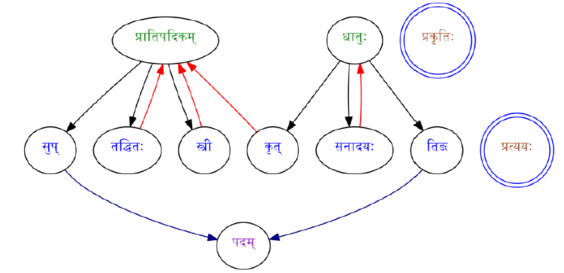Difference between revisions of "Desiderative (सन् प्रत्ययः)"
Jump to navigation
Jump to search
(Creating a new page) |
(Added image) |
||
| (One intermediate revision by one other user not shown) | |||
| Line 1: | Line 1: | ||
| + | [[File:7 Prakrti Pratyaya.PNG|thumb|564x564px|San Pratyaya. Copyright: Sridhar Subbanna.]] | ||
What is सन् ? | What is सन् ? | ||
| Line 14: | Line 15: | ||
Since the newly formed one is a धातु, all the प्रत्ययऽ that are applicable to धातु are applicable. Hence, चिकीर्षति-चिकीर्षतः-चिकीर्षन्ति on तिङ्-लट्-लकार, चिकीर्षु on a कृत-प्रत्यय-उ etc | Since the newly formed one is a धातु, all the प्रत्ययऽ that are applicable to धातु are applicable. Hence, चिकीर्षति-चिकीर्षतः-चिकीर्षन्ति on तिङ्-लट्-लकार, चिकीर्षु on a कृत-प्रत्यय-उ etc | ||
| + | [[Category:Vyakarana]] | ||
Latest revision as of 18:27, 19 September 2022
What is सन् ?
सन् - is a प्रत्यय Prescribed on a धातु in the meaning of desire do the action and resulting in a new धातु. It is also known as desiderative.
धातु + सन्=> धातु
० डुकृञ् + सन्=> चिकीर्ष , डुकृञ् - to do, चिकीर्ष - desire/like to do
० गम्लृ + सन् => जिगमिष , गम्लृ - to go, जिगमिष - desire/like to go
० पा + सन् => पिपास , पा - to drink , पिपास - desire/like to drink
० ज्ञा + सन् => जिज्ञास , ज्ञा - to Know , जिज्ञास - desire/like to know
Since the newly formed one is a धातु, all the प्रत्ययऽ that are applicable to धातु are applicable. Hence, चिकीर्षति-चिकीर्षतः-चिकीर्षन्ति on तिङ्-लट्-लकार, चिकीर्षु on a कृत-प्रत्यय-उ etc
